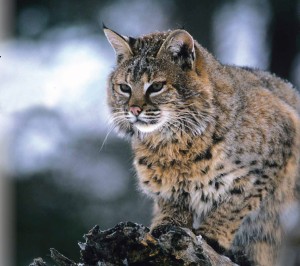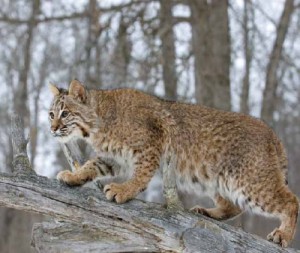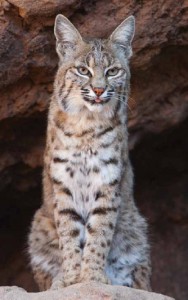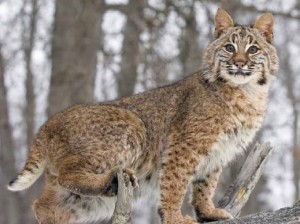 The old maple tree was perfect for my purposes. This amounted to getting high enough off the ground that should a deer come down the well-established trail that ran along the ridgeline, I would be fifteen feet or so above its line of sight. So unless I made a sudden move, or an inopportune wind caught my scent and carried it into the deer’s face, I would be able to come to full draw with my bow and get a shot of no more than thirty yards.
The old maple tree was perfect for my purposes. This amounted to getting high enough off the ground that should a deer come down the well-established trail that ran along the ridgeline, I would be fifteen feet or so above its line of sight. So unless I made a sudden move, or an inopportune wind caught my scent and carried it into the deer’s face, I would be able to come to full draw with my bow and get a shot of no more than thirty yards.
That was the theory, anyway. And since a split in the tree’s trunk made it easy to climb, I had been testing it every day for a week.
So far, I had seen one bear, several turkeys, and a multitude of squirrels. They were all feeding on acorns that had fallen off the oak trees that had caught my attention and convinced me that this ridge would make a good place to hunt this season. But no deer had used the trail while I was perched in the maple. Going by the sign, they had been using the ridge; just not when I was around, which was in the late afternoon right up until dusk when it was no longer legal to hunt. That had always been the best time for me.
So, using my formidable powers of deduction, I concluded that the deer were feeding here either at night, during the middle of the day, or at first light. I would have to hunt at one of those times.
Night was out of the question. It is illegal to hunt then. The middle of the day represented working hours and, anyway, in my experience, deer were not especially active then and my patience for sitting up in a tree was limited to a couple of hours. So this left the early hours when the thin, watery light of dawn began to seep down through the high branches of the trees and the woods began to take shape. I liked everything about the idea except for climbing the tree in the dark.
But I managed that part of it and when dawn arrived on a clear, cold morning, I was twenty feet off the ground, shivering and wishing I’d worn more clothes.
A few coyotes called and their sound seemed less exotic and melancholy than it did at night. In the morning, the coyotes could have been dogs who were sounding off just because they could. The howling of the coyotes inevitably provoked some crows who made their own distinctive racket. The woods, I thought, can be a pretty noisy place first thing in the morning.
I was refining that thought when something caught my eye. Movement. I tensed up and turned my head slowly, expecting to see a deer easing down the trail and coming into range.
At first, I didn’t see anything at all and thought that, maybe, I’d imagined the movement. Then, I thought I could make out the shape of something. But it wasn’t easy, in the dappled early morning light.
I kept watching and gradually became more certain of what I was looking at. It was a bobcat and I was more excited than if it had been a deer. This was one of those moments in the woods; the kind where your attention is totally absorbed and you feel like you are a sort of invisible spectator in another world. The kind of moment that you remember for a long time after you have lived it.
This was one of those moments in the woods; the kind where your attention is totally absorbed and you feel like you are a sort of invisible spectator in another world. The kind of moment that you remember for a long time after you have lived it.
It was a the first bobcat I’d ever seen in Vermont. And I knew enough, had heard enough stories from people a lot more experienced in the woods than I, to know that this was also likely to be the last bobcat I would ever see in Vermont.
“Oh, there are plenty of them around,” a man I’d asked about “cats” had once told me. “They aren’t rare or endangered or anything like that. You just don’t see them. Sometimes you don’t see them even when you are looking right at them. They’re like deer that way. Perfect coloring. But most of the time you don’t see them because they aren’t there when you’re looking.”
Which struck me as a sort of Zen-like explanation. But I didn’t ask any follow-ups. Instead, I did some research—reading and questioning— and learned that one of the reasons bobcats are so seldom seen by humans is that they are active early in the morning and late in the day. They are, to use the technical term, crespucular. What it comes down to is that they are active when humans are not.
But there is more to it, I think, than scheduling. A lot of animals are more active around sunrise and sunset than at other times of day. Deer, for instance. And everyone in Vermont has seen deer. So many that it isn’t really much of an event. Just slightly more exciting than seeing … oh, a cow.
The bobcat is different. Even the people I know who have spent a lot of time in the woods and are utterly at home there tell me that they have seen bobcats so seldom that they can remember every encounter. And they still consider it something special when they do get a look at one.
“Neat little animal,” a man who has made his living, like his father before him, buying and selling fur and supplying trappers with the essentials of their trade. “I’ll see one, now and then, and I don’t have any urge to do anything but watch. Can’t imagine shooting one.”
He buys and sells a few bobcat pelts, he says. They aren’t really that hard to trap.
“They’re cats,” he says. “And not much when it comes to a sense of smell. Not like a fox or a coyote. They can smell the human scent on a trap and if there isn’t any human scent, then they can smell the steel. Bobcat doesn’t have that. But they’ve got the eyes. So someone making a set for one might put a bird wing or a turkey feather in a low tree limb, just above the trap.”
Biologists will tell you to look at the skull of a bobcat and note the size of the eye sockets and compare it to the space for the animal’s nose. This may account for why they are so seldom seen by humans. They see us first. This is an animal that plainly depends on visual signals for survival.
And survival hasn’t necessarily been an easy thing for the bobcat. One hundred and fifty years ago, when Vermont had been vigorously and thoroughly cleared for the timber and to make the land suitable for agriculture, the bobcat had to cope with a dramatic loss of suitable habitat. And for over one hundred years, it was one of several species that was considered undesirable enough that a bounty was paid upon proof of a bobcat kill.
“I believe the bounty was ten dollars,” says Jack Stannard, who knows the Northshire woods as well as anyone.
“That was good money, back in the 40s. New York had a bounty back then, too. And there were a lot of bobcat ears that made it back and forth over the line, several times.”
The bobcat, however, was resourceful and cunning enough to survive bounty hunting and loss of habitat. So unlike the mountain lion—known hereabouts as a “catamount”—it was still around when people began to abandon the farms for factory work and the land went into the kind of early forestation which is favored by so many species of wildlife, including the bobcat. And, then, in the 1970s, the bounty on bobcats was discontinued.
The bounty had been the product of a sort of generalized attitude about predatory animals to include mountain lions and wolves.
This attitude was sustained by the fact that these animals did occasionally kill the kind of animals that humans depended on for their survival. Livestock and chickens. And, then, wilderness and civilization were considered incompatible in those times. Clearing the land and killing off the predators was the essence of “progress.” These attitudes, of course, have changed and the land is now reforested. (Perhaps even excessively so with more mature, canopied forest than is good for wildlife.) The wildlife has also returned. Vermont has healthy populations of bear, deer, turkey and other species to include bobcat.
Wildlife biologists are not sure precisely how many. As many as 3,000, perhaps, statewide. Enough, certainly, that the animal is not considered endangered or threatened. Enough, in fact, that there is a short trapping season and a slightly longer hunting season during which the bobcat may be legally taken. Statewide, the total take, with road kill added, is less than 100 animals, annually.
“Oh, there are plenty of them around…They aren’t rare or endangered or anything like that. You just don’t see them. Sometimes you don’t see them even when you are looking right at them. They’re like deer that way. Perfect coloring. But most of the time you don’t see them because they aren’t there when you’re looking.”
Humans, then, are no threat to the bobcat. And vice versa. Though as with every other wildlife species, there are encounters that humans find inconvenient. Beaver block up culverts and cause flooding. Deer browse ornamental shrubs and kill them. And bobcats will sometimes kill pets.
“It happens,” says Chris Bernier, a wildlife biologist with the Vermont Department of Fish & Wildlife.
When it comes to diet, Bernier says, “The bobcat is a generalist. It won’t refuse anything. Unlike its close relative, the lynx, whose diet consists almost exclusively of snowshoe hare, a bobcat will kill and eat rabbits, squirrel, birds … even porcupines, though that is more a fisher’s prey. And like all other predators, bobcats will kill chickens. And, sometimes, they will kill a pet dog or, especially, a pet cat.
The threat to domestic animals— pet cats or free-range chickens— is part of living in a place where wildlife populations are healthy and, even, robust. So many species have rebounded in Vermont that several populations now interact and their interdependence has created a healthy, sustainable wildlife ecology.
“I believe we may have more bobcats than some people think,” Jack Stannard says, and he spends enough time in the woods to know. “The reason the bobcats are doing so well is that the turkeys are thriving. And a young turkey makes a nice dinner for a bobcat. They are excellent stalkers, with great eyesight, and they can sneak up close to a turkey and then finish with a charge before the turkey can get airborne.”
He’s seen it happen, Stannard says.
“Oh, I’m sure that there is predation of turkeys by bobcats,” Bernier says.
And that is, actually, a good news story. All these species of wildlife interact and compete for habitat and food. The return of the turkey to the Vermont woods is a wildlife management success. Turkeys disappeared from Vermont in the 1800s. In 1969, a few dozen were reintroduced to the state, largely in the Pawlet Valley. They took hold and there are now turkeys in every part of Vermont. A lot of them. So many, that some deer hunters worry there may be too many. The turkeys, they say eat acorns and beech nuts that might otherwise sustain the deer herd.
From a management perspective, then, Bernier says, “Bobcats preying on turkey isn’t a bad thing. Ultimately, it helps maintain the balance you are looking for.”
It is, as they used to say, nature’s way. The occasional pet—cat or dog—that is killed by a bobcat is the price we pay for living where there are healthy populations of wild animals. And it isn’t something that is unavoidable.
“When we hear complaints about bobcats taking house cats or dogs,” Bernier says, “I tell people that the best protection is to keep your pets inside around dawn and dusk when these animals are up and moving and on the hunt. And this, incidentally, is also a time when they are at risk from vehicles. More people on the road, driving in less than ideal visibility.”
These are things to consider when you are thinking about bobcats in the abstract. But when you are actually watching one that is in its element, as I was that day from my perch in the old, lightning-blasted tree, your thoughts flow down different channels. And, in fact, you probably don’t actually “think” so much as respond in a visceral fashion, like the outsider that you are. You are, you realize without thinking, a member of just one more prey species. Not that you are in danger of being attacked and taken down by a bobcat. They are small. Under thirty pounds, most of them.
But that isn’t the measure. It is the way the animal moves when it is on the hunt. With a kind of effortless, alert tension. No sound. No sudden movement. As fluid and soundless as smoke and utterly in his element.
The bobcat moved down the trail, seeming to change color as it slipped in and out of shadow and sunlight— tawny, with the spots not showing dramatically, but there. And the flat, patient face turning in this direction, then the other, as it searched out the woods, using that acute eyesight.
It wasn’t long, maybe fifteen minutes, before the bobcat had disappeared from sight. I felt like I hadn’t breathed the whole time. He was still close, I knew. But I wouldn’t see him again.
Might not ever see a bobcat again, for that matter.
Still … they’re out there. ◊
Geoffrey Norman is a Dorset author and frequent contributor to STRATTON MAGAZINE.




